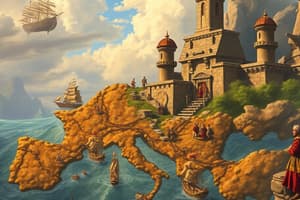Podcast
Questions and Answers
Why did Western explorers decide to travel east?
Why did Western explorers decide to travel east?
- To find glory and gold
- To encounter the Muslim world
- To escape the Age of Enlightenment
- To grow rich and spread Christianity (correct)
What inspired many people to become adventurers on the high seas in the 1400s?
What inspired many people to become adventurers on the high seas in the 1400s?
- The encounter with the Muslim world by the Crusaders
- The desire to find glory and gold
- The dominance of the Europeans in trade routes
- The Age of Enlightenment (correct)
What were some of the Eastern goods in high demand?
What were some of the Eastern goods in high demand?
- Tea and porcelain
- Nutmeg, ginger, cinnamon, pepper, and others (correct)
- Silk and cotton
- Wheat and barley
What did Marco Polo's journey to Kublai Khan in China demonstrate?
What did Marco Polo's journey to Kublai Khan in China demonstrate?
Which European country led the way in exploring the East and establishing trading outposts in Africa and India?
Which European country led the way in exploring the East and establishing trading outposts in Africa and India?
Which sailor reached Calicut, India in 1498, opening a direct sea route to India?
Which sailor reached Calicut, India in 1498, opening a direct sea route to India?
Which sailing vessel enabled Western sailors to sail against the wind and calculate latitude?
Which sailing vessel enabled Western sailors to sail against the wind and calculate latitude?
Which European powers challenged Portugal's trade empire with larger fleets and formed their own East India Companies?
Which European powers challenged Portugal's trade empire with larger fleets and formed their own East India Companies?
What led to tensions between Spain and Portugal over claimed lands, resulting in the Treaty of Tordesillas and the Line of Demarcation?
What led to tensions between Spain and Portugal over claimed lands, resulting in the Treaty of Tordesillas and the Line of Demarcation?
Who sailed west across the Atlantic in 1492, reaching the Caribbean and unwittingly opening the way to the colonization of the Americas?
Who sailed west across the Atlantic in 1492, reaching the Caribbean and unwittingly opening the way to the colonization of the Americas?
Who later claimed the Philippines and began settling in 1565, leading to further competition between Spain and Portugal?
Who later claimed the Philippines and began settling in 1565, leading to further competition between Spain and Portugal?
Which country established Batavia on Java as their trading headquarters and took control of the Spice Islands and the Cape of Good Hope?
Which country established Batavia on Java as their trading headquarters and took control of the Spice Islands and the Cape of Good Hope?
What were Europeans primarily driven by when they began exploring Asia to establish their own trading empires?
What were Europeans primarily driven by when they began exploring Asia to establish their own trading empires?
What common instrument did Western sailors use to calculate latitude through stars and degrees?
What common instrument did Western sailors use to calculate latitude through stars and degrees?
What was the name of the treaty that resulted from tensions between Spain and Portugal over claimed lands?
What was the name of the treaty that resulted from tensions between Spain and Portugal over claimed lands?
In which century did the British and French establish outposts in India?
In which century did the British and French establish outposts in India?
Flashcards are hidden until you start studying
Study Notes
- Europeans sought to bypass Italian trading routes and reach the East for riches, Christianity, and glory
- The Caravel, a 65 ft long ship with triangular sails and the Astrolabe with stars and degrees, enabled Western sailors to sail against the wind and calculate latitude
- Portugal led the way in exploring the East, establishing trading outposts in Africa and later India, discovering spices, gold, ivory, and slaves
- In 1498, Vasco da Gama reached Calicut, India, and opened a direct sea route to India, bringing back vast riches
- Christopher Columbus, backed by Spain in 1492, sailed west across the Atlantic, reaching the Caribbean and unwittingly opening the way to the colonization of the Americas
- Tensions between Spain and Portugal arose over claimed lands, leading to the Treaty of Tordesillas and the Line of Demarcation
- Portugal took control of the spice trade, using added cannons and defeating Muslim fleets in the East
- Spain later claimed the Philippines and began settling in 1565, leading to further competition between Spain and Portugal
- European powers, driven by greed, began exploring Asia to establish their own trading empires
- The Dutch and English challenged Portugal's trade empire with larger fleets and formed their own East India Companies
- The Dutch established Batavia on Java as their trading headquarters and took control of the Spice Islands and the Cape of Good Hope.
- The British and French also established outposts in India in the 17th century.
- A 17th-century sailing vessel carried 8,000 lbs of salt beef, 2,800 lbs of salt pork, 600 lbs of salt cod and beef tongues, 15,000 brown biscuits, 5,000 white biscuits, 30 bushels of oatmeal, 40 bushels of dried peas, 1 1/2 bushels of mustard seed, 1 barrel of salt, 1 barrel of flour, 11 small wooden casks of butter, 1 large cask of vinegar, 10,500 gallons of beer, 3,500 gallons of water, and 2 casks of cider for a crew of 190.
Studying That Suits You
Use AI to generate personalized quizzes and flashcards to suit your learning preferences.




